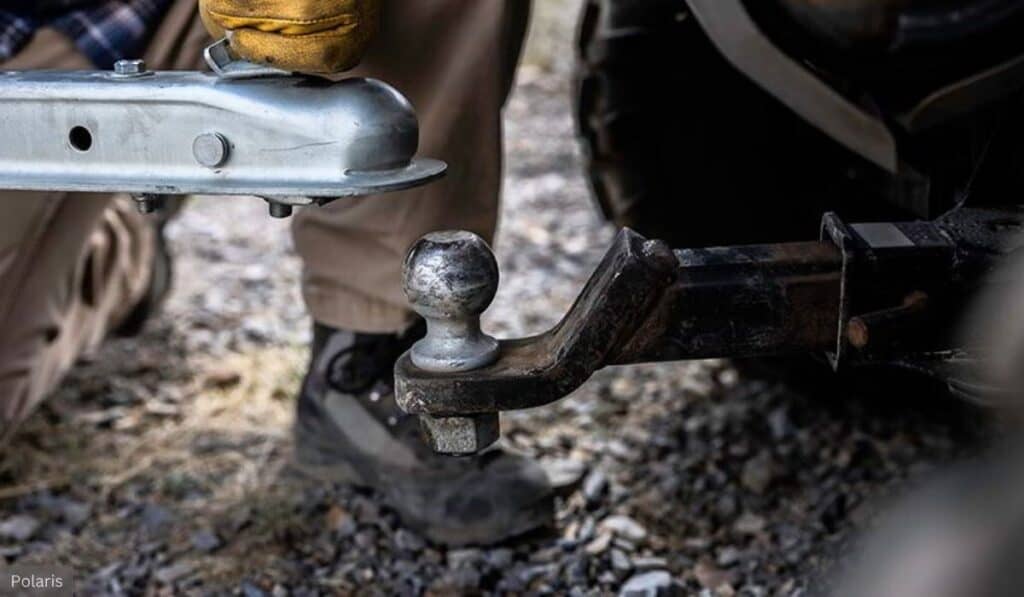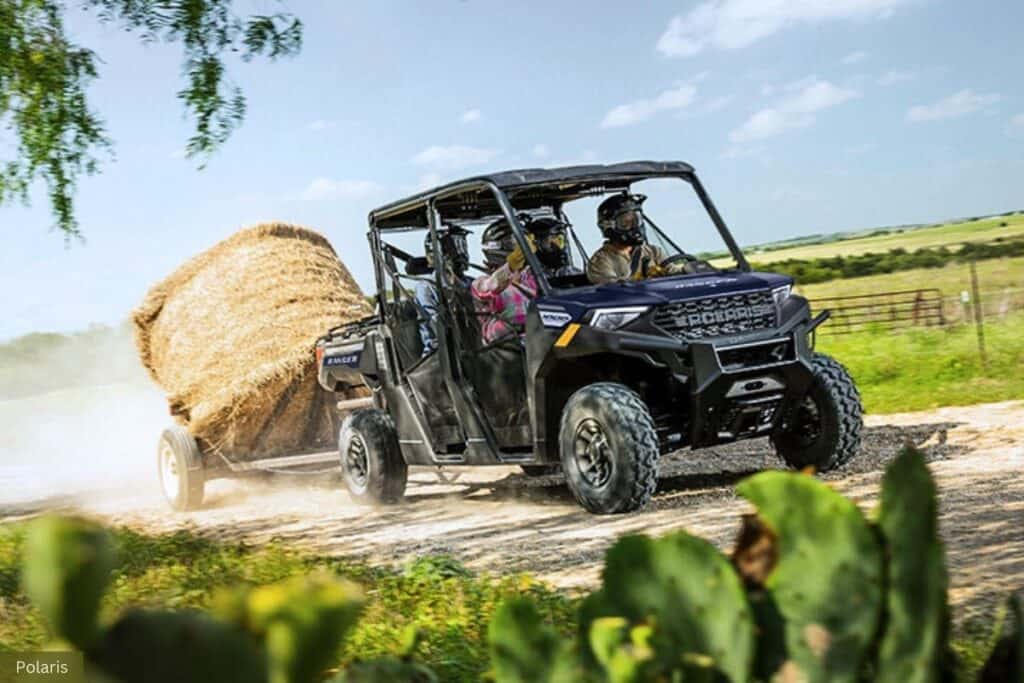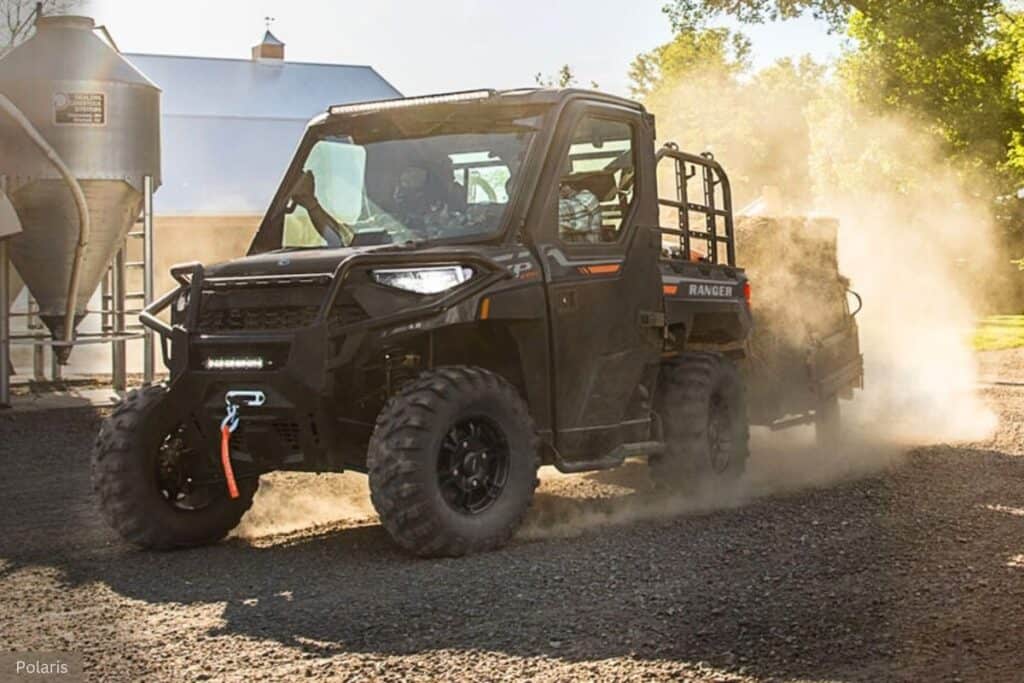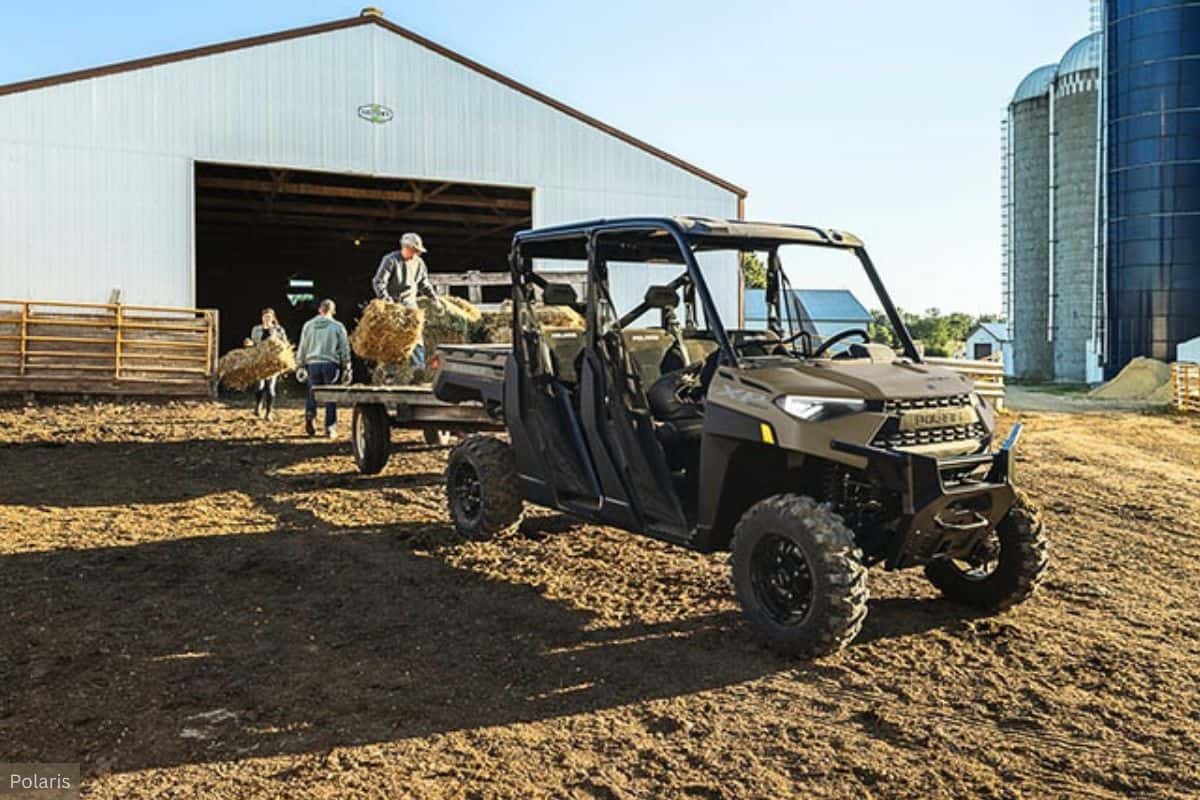There are many key factors to consider when choosing a utility terrain vehicle or UTV, including engine size, horsepower, weight, and payload capacity.
For those who plan to use their UTV for work, however, one of the most important factors to consider is its towing capacity.
If you’re new to ATV towing though, you might be wondering how much a UTV can tow.
To answer this question, we created this resource to not only answer, how much a UTV or side-by-side can tow but also what a good UTV towing capacity is by comparing 19 popular models against each other.
Key Takeaways
- The average towing capacity for UTVs ranges from 1,000 to 2,500 pounds, with utility models generally offering higher capacities compared to sport models.
- Factors such as engine power, transmission, suspension, frame design, vehicle weight, and dimensions significantly influence a UTV’s towing capacity.
- The Polaris Ranger Crew XP 1000, Can-Am Defender 6X6 DPS HD10, and John Deere XUV835E offer some of the highest towing capacities, topping out at 4,000 pounds.
Popular UTV Models (Lowest to Highest Tow Rating)
| Make/Model/Trim | Towing Capacity | Engine Displacement | Class |
|---|---|---|---|
| 1. Honda Pioneer 520 | 1,000 lbs | 518cc | Utility |
| 2. Arctic Cat Prowler Pro EPS | 1,000 lbs | 812cc | Utility |
| 3. Honda Pioneer 1000 | 1,000 lbs | 999cc | Utility |
| 4. Cub Cadet Challenger MX750 EPS | 1,000 lbs | 735cc | Utility |
| 5. Kubota RTV520 | 1,168 lbs | 514cc | Utility |
| 6. Polaris Ranger SP 570 | 1,500 lbs | 567cc | Utility |
| 7. Can-Am Maverick Trail DPS 1000 | 1,500 lbs | 976cc | Sport |
| 8. Polaris RZR Trail Ultimate | 1,500 lbs | 875cc | Sport |
| 9. Yamaha Viking VI EPS | 1,500 lbs | 686cc | Utility |
| 10. John Deere XUV560E | 1,500 lbs | 570cc | Utility |
| 11. CFMOTO ZFORCE 800 Trail | 1,500 lbs | 800cc | Sport |
| 12. Kubota Sidekick RTV-XG850 | 2,000 lbs | 851cc | Utility |
| 13. Can-Am Commander DPS 700 | 2,000 lbs | 650cc | Sport |
| 14. Kawasaki Mule PRO-FXT | 2,000 lbs | 812cc | Utility |
| 15. Can-Am Defender Cab DPS HD9 | 2,500 lbs | 976cc | Utility |
| 16. Bobcat UV34 | 2,500 lbs | 1000cc | Utility |
| 17. Polaris Ranger Crew XP 1000 | 2,500 lbs | 999cc | Utility |
| 18. Can-Am Defender 6X6 DPS HD10 | 3,000 lbs | 976cc | Utility |
| 19. John Deere XUV835E | 4,000 lbs | 812cc | Utility |
Average UTV Towing Capacity
When discussing the towing capabilities of side-by-sides, it’s important to understand the average towing capacity across various models and manufacturers.
While towing capacities can vary greatly depending on the specific UTV and its intended use, most modern side-by-sides offer a towing capacity ranging from 1,000 to 2,500 pounds, with some high-end models approaching or even exceeding the 3,000-pound mark.
Utility-focused side-by-sides, designed for work and heavy-duty applications, typically offer higher towing capacities compared to sport-oriented models.
These UTVs often feature larger engines, stronger frames, and more robust suspension systems, allowing them to safely and efficiently tow heavier loads. On average, utility side-by-sides tow anywhere from 1,500 to 2,500 pounds, however, smaller entry-level models can tow as little as 1,000 pounds.
Sport side-by-sides, on the other hand, prioritize performance and agility over towing capabilities. As a result, these models generally have lower towing capacities, ranging from 1,000 to 2,000 pounds.
Understanding UTV Towing Capacity

To fully understand UTV towing capacity, it’s important to not only define what it means but also figure out what affects it.
UTV towing capacity refers to the maximum weight a UTV or side-by-side can safely tow without compromising its performance, stability, or safety.
This weight encompasses the combined total weight of the trailer and its cargo.
Overloading a UTV by pulling weight beyond its capacity can cause premature wear and tear on its components, potential damage to the vehicle, and an increased risk of accidents, which could result in injuries or fatalities.
Factors that Impact Side-By-Side Towing Capability

When considering the towing capabilities of a side-by-side or UTV, it’s important to understand the various factors that influence their tow rating.
As these factors play a crucial role in determining how much weight they can safely tow.
So in this section, we’ll explore the key factors that impact side-by-side towing capacity, including engine power, transmission, suspension, and more, to provide an overview of what affects a UTV’s ability to tow heavy loads.
Engine Power & Torque
Engine power and torque are key factors that significantly influence a side-by-side’s towing capacity.
The engine’s power output, measured in horsepower (HP), determines the vehicle’s overall performance and its ability to pull heavy loads.
Torque, on the other hand, measured in foot-pounds (ft-lbs) or Newton meters (Nm), indicates the rotational force generated by the engine, which is particularly important for towing.
Higher torque output allows the side-by-side to efficiently transfer power to the wheels, enabling it to overcome the resistance of the added weight and maintain steady progress.
Generally, UTVs with larger engines and displacements, such as 700cc or more, tend to offer higher power and torque figures, translating to better towing capabilities compared to smaller engines.
Transmission & Gearing
The transmission and gearing of a side-by-side also play a key role in its towing capacity, as they work in tandem with the engine to efficiently transfer power to the wheels.
A heavy-duty transmission helps optimize the engine’s power output, ensuring the vehicle can maintain proper speed and control while towing heavy loads.
Many UTVs feature continuously variable transmissions (CVTs), which provide smooth, seamless power delivery across a wide range of speeds. Some models also offer selectable gearing options, such as high and low ranges, which can be advantageous for towing.
Low-range gearing provides more torque at lower speeds, making it easier for the side-by-side to pull heavy loads and navigate challenging terrain.
High-range gearing, on the other hand, allows for higher speeds while towing, which can be beneficial for covering longer distances or maintaining a steady pace on flat surfaces.
Suspension & Braking
While everyone pays attention to engine size and power when looking for a UTV with a good towing capacity, most underestimate the importance of a heavy-duty suspension and a good braking system, which is a big mistake.
As they both help to maintain stability, control, and safety when hauling heavy loads.
For example, a robust suspension system, which typically features independent front and rear suspension components, helps absorb the added weight and stress of towing, keeping the vehicle stable and minimizing body roll.
In addition, equally important to towing is a reliable and efficient braking system, which ensures that the side-by-side can safely slow down and stop, even with the added weight of a trailer.
Many modern UTVs feature hydraulic disc brakes on all four wheels, providing strong and consistent stopping power. Some models also include advanced braking technologies, such as engine braking or electronic brakeforce distribution, which help to enhance control and stability during towing.
Frame Strength & Design
Another key feature that often gets overlooked when shopping for a UTV for towing is its frame and design.
This is also a mistake though, as the frame and overall design of the UTV provide the foundation for its towing capability.
This is because the frame serves as the backbone of the vehicle and must withstand the added stress and strain of hauling heavy loads.
A well-engineered frame is crucial for maintaining the structural integrity of the UTV and ensuring safe and reliable towing performance.
The type or class of the UTV can also have a big impact on its towing capacity, as utility-focused UTVs tend to have a higher tow rating compared to sport-focused UTVs.
In fact, many sport UTVs are not equipped or rated for towing at all, especially high-performance models like the Arctic Cat Wildcat XX Black Hills Edition and the Polaris RZR Turbo R 4 Ultimate.
Vehicle Weight & Dimensions
The final factor that can have a big impact on side-by-side towing performance is this vehicle’s weight and dimensions.
The overall weight of the UTV itself plays a significant role in determining how much additional weight it can safely tow. In general, heavier side-by-sides tend to have higher towing capacities compared to lighter models, as their increased mass provides a more stable platform for hauling heavy loads.
Weight distribution is also important, as a well-balanced UTV will offer better stability and control when towing.
In addition to weight, the overall dimensions of the side-by-side can impact its towing capacity.
Many utility-focused side-by-sides feature a longer wheelbase, which helps to distribute the weight of the vehicle and the towed load more evenly. This longer wheelbase also contributes to improved stability, reducing the risk of the UTV becoming unsettled or losing traction when hauling heavy cargo.
Wider UTVs also tend to offer better stability and resistance to tipping or rolling when towing, as their increased width provides a more stable base.
UTVs With the Highest Towing Capacity

When it comes to towing heavy loads with a side-by-side, certain models stand out from the crowd, due to their high tow rating.
While these models are often the largest and most expensive, they’re specifically designed for those with demanding jobs that require the highest payload and towing capacities.
To see what sets these titans of towing apart from the average side-by-side, we’ve highlighted three of the most powerful UTVs with the highest towing capacities.
Polaris Ranger Crew XP 1000
Quick Specs
- Average Price: $31,000
- Displacement: 999cc
- Engine: ProStar Fuel-injected Liquid-cooled 4-Stroke Twin-cylinder DOHC
- Horsepower: 82 HP
- Towing Capacity: 2,500 Pounds
- Bed Capacity: 1,000 Pounds
- Ground Clearance: 13 Inches
With a towing capacity of 2,500 pounds, the Polaris Ranger Crew XP 1000 offers class-leading towing capability.
This powerful utility side-by-side is designed to tackle the toughest hauling, thanks to its robust 82-horsepower ProStar 999cc engine and all-new stronger drive system designed for heavier towing and hauling work.
The Ranger Crew XP 1000’s impressive towing capacity is supported by a strong, reinforced frame and a heavy-duty suspension system that includes adjustable front and rear shocks.
This combination of power, strength, and versatility makes it an ideal choice for those who require a reliable workhorse for demanding jobs, such as hauling heavy equipment or supplies.
The Polaris Ranger Crew XP 1000 also offers a spacious cabin that can comfortably seat up to six passengers, making it a great option for work crews or families who need a capable and versatile side-by-side.
With its industry-leading towing capacity and user-friendly features, the Polaris Ranger Crew XP 1000 is a top contender for anyone needing a powerful and dependable towing machine.
For more information on the Polaris Ranger Crew XP 1000, check out Polaris’s website here.
Can-Am Defender 6X6 DPS HD10
Quick Specs
- Average Price: $18,500
- Displacement: 976cc
- Engine: Rotax V-twin Liquid-cooled
- Horsepower: 82 HP
- Towing Capacity: 3,000 Pounds
- Bed Capacity: 1,000 Pounds
- Ground Clearance: 13 Inches
It’s easy to see that the Can-Am Defender 6X6 DPS HD10 is no ordinary UTV, thanks to its unique 6-wheel design, which allows this off-road beast to go places normal side-by-side would never dream of going.
However, while the 6×6 design gets most of the attention, what many don’t know is that it also offers class-leading towing capacity, as the Defender 6X6 DPS HD10 has a massive 3,000-pound tow rating.
Making it one of the most capable towing machines in the side-by-side market.
Powered by a potent 82-horsepower Rotax V-twin engine and featuring a reinforced frame, the Defender 6X6 DPS HD10 is built to handle the most demanding hauling tasks.
Plus, the additional pair of wheels not only provides unparalleled traction and stability in rough terrain but also helps to distribute the weight of heavy loads more evenly, enhancing the vehicle’s towing performance.
The Can-Am Defender 6X6 DPS HD10 also boasts a versatile cargo box with a dump feature, which can be adapted to carry a wide range of gear and supplies, making it an ideal choice for those who need to transport both heavy equipment and smaller items.
With its unique combination of exceptional towing capacity, unrivaled off-road capability, and versatile cargo solutions, the Can-Am Defender 6X6 DPS HD10 is a top choice for anyone who demands the ultimate in utility and performance from their side-by-side.
To learn more about the Can-Am Defender 6X6 DPS HD10, visit Can-Am’s website by clicking here.
John Deere XUV835E
Quick Specs
- Average Price: $20,000
- Displacement: 812cc
- Engine: Fuel-injected Liquid-cooled 4-cycle
- Horsepower: 54 HP
- Towing Capacity: 4,000 Pounds
- Bed Capacity: 1,000 Pounds
- Ground Clearance: 11.2 Inches
If you’re looking for a UTV with unrivaled towing capacity, the John Deere XUV835E stands out as the clear winner.
As this towing powerhouse boasts an impressive 4,000-pound towing capacity, making it the best-in-class option for those who need to haul heavy loads with their side-by-side.
The John Deere XUV835E is the go-to choice for tackling the most demanding hauling jobs, as it’s engineered to handle the toughest towing challenges with ease.
Plus, the vehicle’s advanced transmission and four-wheel drive system ensure optimal power delivery and traction, even when hauling large loads over rough terrain.
In addition to its class-leading towing capacity, the John Deere XUV835E also offers a spacious cargo box, capable of accommodating up to 1,000 pounds of payload.
This combination of outstanding towing and hauling capabilities makes the XUV835E an incredibly versatile machine, suitable for a wide range of demanding jobs.
Whether you’re a farmer, contractor, or simply someone who needs a reliable and powerful side-by-side for heavy-duty tasks, the John Deere XUV835E is an excellent option.
For more information on the John Deere XUV835E, visit John Deere’s website here.
Have More UTV Towing Questions? We’ve Got More Answers:
Additional UTV Resources:
- Do UTVs Flip Easily? (The Truth You Need to Know)
- Are All UTVs 4×4? The Answer Might Suprise You
- What Size Trailer Will a Side-By-Side Fit on? Find Out Here
Recent Posts
In recent years, off-road enthusiasts have been taking their adventures to the next level by installing UTV underglow lights on their side-by-sides. Which adds a unique visual appeal and improves...
Side by sides, also known as UTVs, are used by a wide range of outdoor enthusiasts from off-roaders to farmers to ranchers, and hunters. As these versatile machines offer a unique blend of...

